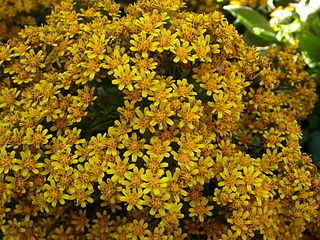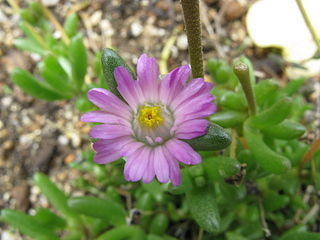
Sequoiadendron giganteum, also known as the giant sequoia, giant redwood or Sierra redwood is a coniferous tree, classified in the family Cupressaceae in the subfamily Sequoioideae. Giant sequoia specimens are the most massive trees on Earth. They occur naturally only in groves on the western slopes of the Sierra Nevada mountain range of California.

Leptospermum scoparium, commonly called mānuka, mānuka myrtle, New Zealand teatree, broom tea-tree, or just tea tree, is a species of flowering plant in the myrtle family Myrtaceae, native to New Zealand and south-east Australia. Its nectar produces Mānuka honey.

The Royal Tasmanian Botanical Gardens (RTBG), which cover an area of approximately 14 hectares, in Hobart located within the Queens Domain.

Rhus typhina, the staghorn sumac, is a species of flowering plant in the family Anacardiaceae, native to eastern North America. It is primarily found in southeastern Canada, the northeastern and midwestern United States, and the Appalachian Mountains, but it is widely cultivated as an ornamental throughout the temperate world. It is an invasive species in some parts of the world.

Lavandula angustifolia, formerly L. officinalis, is a flowering plant in the family Lamiaceae, native to the Mediterranean. Its common names include lavender, true lavender and English lavender ; also garden lavender, common lavender and narrow-leaved lavender.

Lampranthus is a genus of succulent plants in the family Aizoaceae, indigenous to southern Africa.

Prosopis glandulosa, commonly known as honey mesquite, is a species of small to medium-sized, thorny shrub or tree in the legume family (Fabaceae).

Hymenosporum is a monotypic genus of trees in the family Pittosporaceae. The sole included species is Hymenosporum flavum, commonly known as native frangipani, found in the rainforests and wet sclerophyll forests of New Guinea, Queensland and New South Wales. Despite its common name, it is not closely related to the frangipani, but is related to the widespread genus Pittosporum.

Iris albicans, also known as the cemetery iris, white cemetery iris, or the white flag iris, is a species of iris which was planted on graves in Muslim regions and grows in many countries throughout the Middle East and northern Africa. It was later introduced to Spain, and then other European countries. It is a natural hybrid.

Athrotaxis cupressoides, is also known as pencil pine, despite being a species of the family Cupressaceae, and not a member of the pine family. Found either as an erect shrub or as a tree, this species is endemic to Tasmania, Australia. Trees can live for upwards of 1000 years, sustaining a very slow growth rate of approximately 12 mm in diameter per year.

Veronica speciosa, synonym Hebe speciosa, is a species of flowering plant in the family Plantaginaceae, known by the common names New Zealand hebe, showy hebe, showy-speedwell, and the Māori names titirangi and napuka. Like most hebes, it is native to New Zealand but it can be found in other parts of the world where it is grown as an ornamental for its showy flowers.

Acrisione is a genus of the tribe Senecioneae of the family Asteraceae, native to Chile and southern Argentina. It was first described as a genus in 1985.

Hymenocallis littoralis, commonly known as the beach spider lily, is a species of plant in the amaryllis family Amaryllidaceae. It is native to warmer coastal regions of Latin America and a widely cultivated and naturalized plant in many tropical countries.

The Biodiversity of Cape Town is the variety and variability of life within the geographical extent of the City of Cape Town metropolitan municipality, excluding the Prince Edward Islands. The terrestrial vegetation is particularly diverse and much of it is endemic to the city and its vicinity. Terrestrial and freshwater animal life is heavily impacted by urban development and habitat degradation. Marine life of the waters immediately adjacent to the city along the Cape Peninsula and in False Bay is also diverse, and while also impacted by human activity, the habitats are relatively intact.

Peninsula Granite Fynbos is an endangered Fynbos vegetation type which is endemic to the city of Cape Town and occurs nowhere else. It is a unique type of tall, dense and diverse scrubland, scattered with trees. It can be found all along the belt of granite that encircles Table Mountain.

Lampranthus tenuifolius, the narrow-leaf brightfig, is a critically endangered species of succulent plant that is endemic to the Cape Flats Dune Strandveld around Cape Town, South Africa.

The 2016 Tasmanian Bushfires were a large series of bushfires in Tasmania which started in January 2016 throughout the state, and continued into February 2016, with considerable damage to fire sensitive areas in the Central Highlands, West Coast and South West regions. By autumn 2016, no bushfires were reported within the state.

Lampranthus glaucus is a plant species in the genus Lampranthus native to South Africa and naturalized in gardens all around the world.

Lampranthus multiradiatus, synonyms including Lampranthus roseus, known as the creeping redflush or rosy dewplant, is a species of shrub in the family Aizoaceae. They are succulent plants with grey-green shoots. They have a self-supporting growth form and simple, broad leaves. The daisy type flowers have yellow centres and petals that vary between pink and purple depending on the season.

Lampranthus spectabilis, the trailing iceplant, is a species of flowering plant in the family Aizoaceae, native to the Cape Provinces of South Africa. The unimproved species and a number of cultivars are commercially available, including 'Tresco Apricot', 'Tresco Brilliant', 'Tresco Fire', 'Tresco Orange', 'Tresco Peach', 'Tresco Pearl', 'Tresco Purple', and 'Tresco Red'.




















